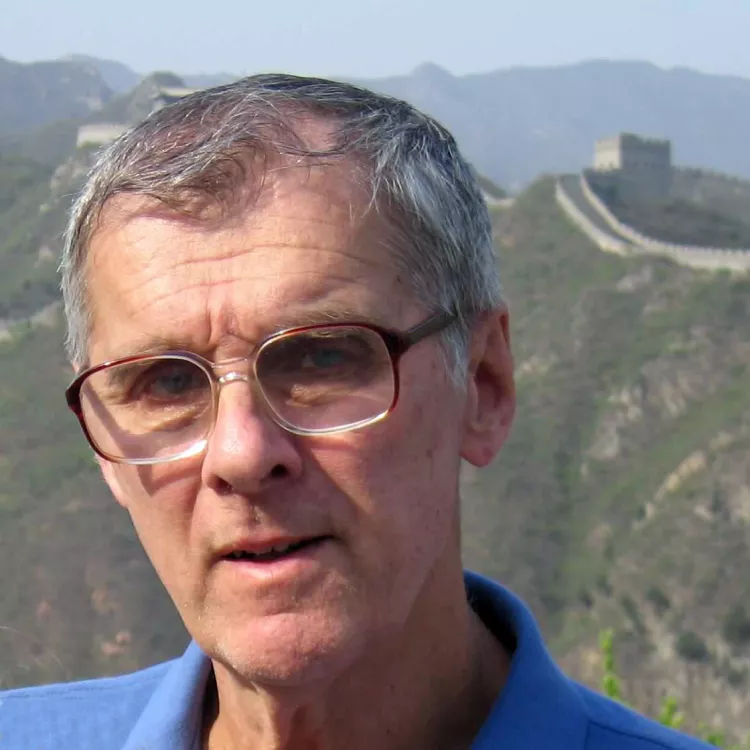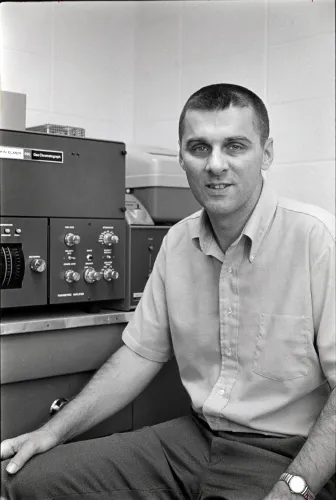In Honor of Professor Emeritus of Chemistry James Hammons

President Valerie Smith shared the following message with the campus community on October 16, 2023:
Dear Friends,
With deep sadness, I write to share the news that Professor Emeritus of Chemistry James Hutchinson Hammons died on Tuesday, Aug. 29. He was 89.
Jim, who served on the faculty for 33 years, is remembered as a dedicated mentor and teacher who inspired students and colleagues alike.
Jim is predeceased by Lis, his wife of 64 years who died in 2020. He is survived by their children, Laura Hammons and Jamie Hammons. A memorial for Jim and Lis is being considered for next summer.
I invite you to read more below about Jim and his many contributions to our community.
Sincerely,
Val Smith
President
In Honor of Professor Emeritus of Chemistry James Hammons
Professor Emeritus of Chemistry James H. Hammons died Aug. 29, at age 89.
“When I joined the faculty in 1985, Jim Hammons was part of a cohort of senior faculty in the Chemistry Department who were role models for what it meant to be committed teachers, sensitive mentors, and dedicated members of the College community,” says Tom Stephenson, James H. Hammons Professor Emeritus of Chemistry. “He was never the loudest person in the room, but was frequently the most thoughtful on matters of curriculum or hiring or what was best for an individual student.”
“He went out of his way to make me feel welcome and part of the faculty community at the College,” says Edmund Allen Professor of Chemistry Paul Rablen. “I remember him telling me that he was happy that he had spent his career at Swarthmore.”
“He was a very fine teacher and much loved by his students,” says Professor Emerita of Chemistry & Biochemistry Judith Voet. “One of them even credited him with getting him through Swarthmore and donated enough money to endow a professorship in his name.”
Hammons grew up in Darien, Conn., and attended Phillips Andover Academy. In 1956, he earned a B.A. in chemistry and music from Amherst College. An announcement of his engagement to Lis, then a senior at Mount Holyoke College, appeared in The New York Times that spring.
Hammons completed an M.A. and Ph.D. in chemistry at Johns Hopkins University. Following postdoctoral fellowships at the University of Southern California and the University of California, Berkeley, he joined Swarthmore’s faculty as a chemistry instructor in 1964.

Jim Hammons in 1964
A physical organic chemist, Hammons worked primarily on the spectroscopy of organic molecules. He received support throughout his career from the National Science Foundation and regularly published on a variety of topics. Hammons also held visiting positions at Eidgenössische Technische Hochschule and Université de Genève in Switzerland, Yale University, and the University of Washington. He chaired Swarthmore’s Chemistry Department department in the 1970s and served as acting chair in 1992, and often hosted dinners with Honors examiners in his home.
When Stephenson chaired the department, he counted on Hammons for quiet support and counsel. “I was especially impressed by Jim’s ability to think outside of the box,” he says, “and to embrace early attempts to reform our laboratory curriculum in ways that were then very unconventional.”
Rablen joined the faculty in 1995 to teach organic chemistry and overlapped with Hammons for his first three semesters. He remembers Hammons as a “real gentleman” who was very supportive, if perhaps unintentionally intimidating.
Hammons asked to sit in on Rablen’s lectures about NMR [nuclear magnetic resonance] spectroscopy in the department’s advanced laboratory class. “He was interested in the new insight I would bring about modern techniques,” says Rablen. “I was honored to have him there in class,” he says, “but also felt under quite some pressure to perform!”
Hammons agreed for Rablen to sit in on his advanced organic chemistry Honors seminar as well.
“That was a terrific learning experience for me; I benefited a great deal from his many years’ worth of accumulated knowledge and insight,” Rablen says. “Jim was also a crystal-clear explainer of even complex subject matter. I still pull from knowledge I gained from him, and many of my problem sets and assignments pull elements from the materials he bequeathed to me.”
Hammons’ skill with clear explanations had a particular resonance with students who struggled to complete the chemistry major, which Stephenson came to understand at Hammons’ 1997 retirement dinner. At the event, a former student, Jeffrey Wolfson ’75, surprised Hammons by establishing a professorship in his name to recognize the inspiring academic and personal guidance he had provided.
“As Wolfson tells the story,” Stephenson says, “he would not have graduated if Jim had not single-handedly dragged him through his final chemistry credits.”
At an event at the end of the 1995-96 academic year, the senior chemistry majors made a “torch” of construction paper and a paper towel roll for Hammons to give to Rablen.
“They said it was the passing of the torch from one generation of organic chemists at Swarthmore to the next,” Rablen says. “I still have that torch, and it reminds me of Jim.”



